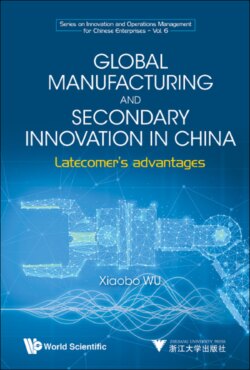Читать книгу Global Manufacturing and Secondary Innovation in China - Xiaobo Wu - Страница 7
На сайте Литреса книга снята с продажи.
Foreword II
ОглавлениеThe next 20 years offer China, as well as its science-technology development, a strategic opportunity for development. Globalization is making China a manufacturing center quickly. However, how to realize the leapfrog from “large manufacturing country” to “large innovation country” remains a focus for all people who are concerned about China’s development.
At present, enhancing China’s independent innovation capabilities has been viewed as the vital link for adjusting economic structure, transforming growing patterns, and improving national competitive power. Moreover, building an innovation-oriented country is a primary strategy. In the new work by Professor Xiaobo Wu, Global Manufacturing and Secondary Innovation in China: Latecomer’s Advantages, the author opens with a micro mechanism research, the innovation mechanism of enterprises and strategic practices, and then analyzes the innovative practices of enterprises under the background of globalization. The main thread of this book is “the interaction between latecomer’s advantages and secondary innovation in global manufacturing”. And the subsequent systematic research outlines how to enhance independent innovation capabilities to gain sustained competitive advantages and win latecomer’s advantages to realize leapfrog development of critical technology for Chinese manufacturing enterprises in an open environment. Finally, Professor Wu develops an open, independent innovative path with the Chinese characteristics, the core of which is making full use of “latecomer’s advantages”.
Traditionally, the view of technology advancements was about “introducing, digesting, and absorbing”, and Western technical innovation theory was based on the environments of developed countries. However, both of these extreme perspectives ignore that developing countries can choose their own path from imitation to innovation in this open and global environment. Based on effective practices taken by Chinese enterprises in “secondary innovation” when introducing technologies, this book begins with the laws of development of technological systems among Chinese manufacturers. Later, it puts forward a “secondary innovation” dynamic nonlinear model with learning and understanding as the basic characteristics, to reveal a critical path through which developing countries could make use of “latecomer’s advantages” to realize technological catch-up. This theory provides an excellent path for governmental decision making and strategy development for enterprises, as well as a new method for this research field. The theoretical research, which is both realistic and progressive, shows the spirit of “seeking truth, pursuing innovation” advocated and upheld by Zhejiang University, and a pragmatic style which is vital in China’s construction of modernization.
Nowadays, according to the significant strategic decision of “building an innovation-oriented country”, Zhejiang University is comprehensively accelerating the construction of the second phase of the “985 Project”, whose core is a scientific and technological innovation platform and a research base for innovation in philosophy and social science. Professor Wu works in the research base for innovation management and sustained competitiveness, which is one of the five important national bases for philosophy and social science at Zhejiang University. The mission of this base is to grasp the frontiers of international research while combining them with China’s reality, to actively participate in the construction of a national innovation system while exploring innovative management theory based on the stances of developing countries, to provide important decision-making support for the sustainable development of China’s economy and society. As for Zhejiang University, it should give full play to the academic advantages in engineering technology and promote the independent innovation of China’s manufacturing industry (especially the equipment manufacturing industry). Besides, promoting the intersection, penetration, and integration of humanities and social sciences, natural sciences and engineering technology is also significant for providing valuable suggestions for “the science and technology development strategy of manufacturing”, a major theoretical and practical matter related to the development of our country.
I sincerely hope that all other national bases for philosophy and social science at Zhejiang University could publish more such achievements to contribute to the construction of our innovative country.
Pan Yunhe
Academician of Chinese Academy of Engineering,
Former President of Zhejiang University
